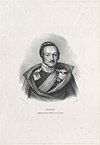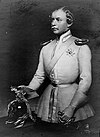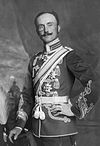House of Lippe
| House of Lippe | |
|---|---|
 | |
| Country | Principality of Lippe, Schaumburg-Lippe |
| Founded | 1123 |
| Founder | Bernhard I |
| Current head | Stephan, Prince of Lippe |
| Final ruler | Leopold IV |
| Titles | Lord, Count, Prince |
| Deposition | 1918 |
| Cadet branches | Lippe-Biesterfeld Lippe-Weissenfeld Schaumburg-Lippe |


The House of Lippe (German: Haus Lippe) is the former reigning house of a number of small German states, two of which existed until the German Revolution of 1918–19, the Principality of Lippe and the Principality of Schaumburg-Lippe.
Princess Beatrix of the Netherlands, former Queen of the Netherlands (1980–2013), is an agnatic member of this house.
History
[edit]The House of Lippe descends from Jodocus Herman, Lord of Lippe (died c. 1096), whose descendant Bernhard I was the founder of the state of Lippe in 1123. Born ca 1090. The family has produced several of the longest-reigning monarchs in Europe, including the longest reigning (for 82 years), Bernard VII, Lord of Lippe (d. 1511). In 1528, Simon V was elevated to the rank of ruling Count of the Holy Roman Empire and Edler Herr zur Lippe (noble Lord of Lippe).[1]
In 1613, the House's territory was split into the counties of Lippe-Detmold, Lippe-Brake and Lippe-Alverdissen. In 1643, Count Philipp of Lippe-Alverdissen inherited half of the neighboring County of Schaumburg and founded the Schaumburg-Lippe line of the House of Lippe. The Brake branch extinguished in 1709, disputedly inherited by the main, Lippe-Detmold line. Alverdissen was bought back from Schaumburg-Lippe by Lippe-Detmold in 1812. In the 18th century, the cadet line of Lippe-Biesterfeld split from the Detmold branch, and shortly thereafter Lippe-Weissenfeld split from Lippe-Biesterfeld as a further cadet branch. Both, Biesterfeld and Weissenfeld were so-called paragiums (non-sovereign estates of a cadet-branch) within the County of Lippe. Both branches, owning only modest manor houses in the county, acquired other (non-sovereign) property by marriage and moved out of the county in the late 18th century, the Biesterfeld branch to the Rhineland, and the Weissenfeld branch to Saxony, where their inherited estates were mostly located.
The counts of Lippe-Detmold were granted the title of Imperial prince in 1789, while the counts of Schaumburg-Lippe became in fact princes by entering the Confederation of the Rhine in 1807 and legally by becoming a member state of the German Confederation in 1815.
The Principality of Lippe existed until the end of the German monarchies in 1918. In 1905, with the death of Alexander, Prince of Lippe, the senior Lippe-Detmold branch of the family became extinct and Count Leopold of Lippe-Biesterfeld (head of the non-ruling junior branch line Lippe-Biesterfeld) succeeded him as Prince, after an Imperial court ruling, in fact against the wishes of Wilhelm II, German Emperor, who would have preferred his brother-in-law Prince Adolf of Schaumburg-Lippe to succeed. Leopold IV continued to rule until the German Revolution of 1918. During the revolution, the ruling Princes of Lippe and Schaumburg-Lippe were forced to abdicate, ending the family's 795-year rule. In 1928, Prince Leopold's three sons by his first wife signed up to the Nazi Party. The eldest, Prince Ernst, was reputedly the first German prince to do so.[2]
In 1937, Prince Bernhard of Lippe-Biesterfeld married Princess Juliana of the Netherlands. On the accession of their daughter Beatrix in 1980, the Netherlands Royal House officially remained known as the House of Orange-Nassau, although Beatrix and her sisters are agnatically members of the House of Lippe.
Stephan, Prince of Lippe (b. 1959) is the present senior of the House of Lippe. He still owns the estate and castle at Detmold, the former main residence of the principality. Alexander, Prince of Schaumburg-Lippe, head of the younger formerly sovereign branch, still resides at Bückeburg Palace, Lower Saxony, located on the border with North Rhine Westphalia.
States ruled by the House of Lippe
[edit]- Lippe (1123–1918), known as Lippe-Detmold from 1621
- Lippe-Brake (1621–1709)
- Schaumburg-Lippe (1643–1918)
Non-ruling cadet branches
[edit]- Lippe-Alverdissen (1613–1640 and 1681–1777)
- Lippe-Biesterfeld
- Lippe-Weissenfeld
Rulers of Lippe
[edit]Partitions of Lippe under Lippe rule
[edit]| County of Sternberg pledged by Holstein (1400) |
|||||
| County of Sternberg (1559-1583) |
Lordship of Lippe (1123-1528) Raised to: County of Lippe (1528-1613) | ||||
| County of Schauenburg (1613-1787) Lippe-Alverdissen line from 1777 |
County of Detmold (1613-1782) |
County of Brake (1613-1709) | |||
| County of Biesterfeld (1627-1905) |
|||||
| County of Weissenfeld (1762-1916) Raised to: Principality of Weissenfeld (1916-1918) |
|||||
| County of Alverdissen (1681-1777) | |||||
| County promoted to Principality of Schaumburg (1787-1918) |
Raised to: Principality of Lippe (1782-1918) Lippe-Biesterfeld line from 1905 | ||||
Table of rulers
[edit]| Ruler | Born | Reign | Ruling part | Consort | Death | Notes | |
|---|---|---|---|---|---|---|---|
| Bernard I | c.1090 First son of ? |
1123 – 1158 | Lordship of Lippe | Unknown at least one child |
1158 aged 67-68 |
First recorded lord of Lippe, and possible founder of the family. | |
| Herman I | c.1090 Second son of ? |
1158 – 1167 | Lordship of Lippe | Unknown at least two children |
1167 Italy aged 76-77 |
||
| Bernard II | 
|
1140 Lippstadt Son of Herman I |
1167 – 1196 | Lordship of Lippe | Heilwig of Are-Hochstaden eleven children |
1224 Mežotne aged 83-84 |
Brother of the previous. Also Lord of Rheda. Abdicated to become an abbot at the Latvian monastery of Daugavgrīva. Eventually he was appointed Bishop at Sēlija in 1218. |
| Herman II | 1175 Lippstadt Son of Bernard II and Heilwig of Are-Hochstaden |
1196 – 26 December 1229 | Lordship of Lippe | Oda of Tecklenburg seven children |
26 December 1229 aged 53-54 |
||
| Bernard III | 1194 Lippstadt Son of Herman II and Oda of Tecklenburg |
26 December 1229 – 1265 | Lordship of Lippe | Sophia of Cuijck-Arnsberg c.1230 five children Sophie of Ravensberg-Vechta (1220-1285) 1248 four children |
1265 aged 70-71 |
||
| Bernard IV | c.1230 Bielefeld First son of Bernard III and Sophia of Cuijck-Arnsberg |
1265 – June 1275 | Lordship of Lippe (at Horn) |
Agnes of Clèves 1260 two children |
June 1275 aged 44-45 |
Sons of Bernard III, disputed the inheritance and briefly divided the lordship: Bernard kept Horn and the eastern part of the land; Herman received Lippstadt, Rheda and the western part. | |
| Herman III | 1233 Second son of Bernard III and Sophia of Cuijck-Arnsberg |
1265 – 3 October 1274 | Lordship of Lippe (at Lippstadt) |
Unmarried | 3 October 1274 aged 40-41 | ||
| Simon I | 1261 Son of Bernard IV and Agnes of Clèves |
June 1275 – 3 August 1344 | Lordship of Lippe | Adelaide of Waldeck 24 November 1276 eleven children |
3 August 1344 aged 82-83 |
Reunited the lordship, but it would be once more divided between his children. | |
| Simon II | c.1280 Fifth son of Simon I and Adelaide of Waldeck |
1334 | Lordship of Lippe | Unmarried | 1334 aged 53-54 |
His situation is not very clear. Despite dying before his father, he is stated as co-ruling with his brothers below. | |
| Bernard V | c.1290 Sixth son of Simon I and Adelaide of Waldeck |
3 August 1344 – 1364 | Lordship of Lippe (at Rheda) |
Richardis of the Mark 16 October 1344 four children |
1364 aged 73-74 |
Sons of Simon I, after the death of their brother Simon not long after their father, the surviving brothers briefly divided the lordship: Bernard kept Rheda and Otto received Lemgo, Rheda | |
| Otto | 
|
1300 Seventh son of Simon I and Adelaide of Waldeck |
3 August 1344 – January 1360 | Lordship of Lippe (at Lemgo) |
Irmgard of the Mark (c.1300-1 August 1362) 4 March 1323 five children |
January 1360 aged 59-60 | |
| Simon III | 1340 Son of Otto and Irmgard of the Mark |
January 1360 – 1410 | Lordship of Lippe | Irmgard of Hoya 1362 ten children |
1410 Lemgo aged 69-70 |
Reunited the lands of Lippe once more. | |
| Bernard VI | 1363 Son of Simon III and Irmgard of Hoya |
1410 – 19 January 1415 | Lordship of Lippe | Margaret of Waldeck-Landau (1363-21 February 1395) 28 June 1393 no children Elisabeth of Mörs-Saarwerden 11 May 1403 four children |
19 January 1415 Detmold aged 51-52 |
||
| Simon IV | 1404 Son of Bernard VI and Elisabeth of Mörs-Saarwerden |
19 January 1415 – 11 August 1429 | Lordship of Lippe | Margaret of Brunswick-Grubenhagen (1411-31 October 1456) 1426 five children |
11 August 1429 aged 24-25 |
||
| Regencies of Otto of Lippe (1429-1433) and Dietrich II, Archbishop of Cologne (1433-1446) | Holds the record of the longest rule in history. Lord since he was less than one year old, he became known as having been involved in many feuds. | ||||||
| Bernard VII the Bellicose |

|
4 December 1428 Son of Simon IV and Margaret of Brunswick-Grubenhagen |
11 August 1429 – 2 April 1511 | Lordship of Lippe | Anna of Holstein-Pinneberg (1428-23 September 1495) 15 September 1443 seven children |
2 April 1511 aged 82 | |
| Simon V | 
|
1471 Son of Bernard VII and Anna of Holstein-Pinneberg |
2 April 1511 – 17 September 1536 | Lordship of Lippe (until 1528) County of Lippe (from 1528) |
Walpurgis of Bronckhorst (d.21 December 1522) 27 March 1490 one child Magdalena of Mansfeld-Mittelort (c.1500-22 September 1540) 16 March 1524 Detmold four children |
17 September 1536 aged 64-65 |
During his rule, the Lordship was elevated to a County. |
| Regency of Philip I, Landgrave of Hesse (1536-1547), Jobst II, Count of Hoya (1536-1545) and Adolphus XIII, Count of Holstein-Pinneberg (1536-1544) | Sons of Simon V, both were minors by the time their father died. Bernard kept Lippe and Herman Simon received the feudal land of Sternberg. Herman Simon would become regent of his nephew, Simon VI. | ||||||
| Bernard VIII | 
|
6 December 1527 Detmold First son of Simon V and Magdalena of Mansfeld-Mittelort |
17 September 1536 – 15 April 1563 | County of Lippe | Catherine of Waldeck-Eisenberg (1524-1583) 1550 five children |
15 April 1563 Detmold aged 35 | |
| Herman Simon | 1532 Second son of Simon V and Magdalena of Mansfeld-Mittelort |
17 September 1536 – 4 June 1576 | County of Sternberg | Ursula of Spiegelberg-Pyrmont (1526-16 March 1583) 18 May 1558 Pyrmont two children |
4 June 1576 aged 43-44 | ||
| Regency of Herman Simon, Count of Sternberg (1563-1576) | His marriage brought the county of Schaumburg (one of the last feuds of the counts of Holstein) into the family's domains. After Simon's death, the county entered into a more permanent division. | ||||||
| Simon VI | 
|
15 April 1554 Son of Bernard VIII and Catherine of Waldeck-Eisenberg |
15 April 1563 – 7 December 1613 | County of Lippe | Armgard, Countess of Rietberg 1578 no children Elisabeth of Holstein-Pinneberg 1585 ten children |
7 December 1613 aged 59 | |
| Regency of Ursula of Spiegelberg-Pyrmont (1576-1578) | His early and childless death brought Sternberg once again under Lippe control. | ||||||
| Philip | 5 October 1560 Son of Herman Simon and Ursula of Spiegelberg-Pyrmont |
4 June 1576 – 11 February 1583 | County of Sternberg | Unmarried | 11 February 1583 Deutz aged 22 | ||
| Annexation to Lippe | |||||||
| Simon VII | 
|
30 December 1587 Lemgo Second son of Simon VI and Elisabeth of Holstein-Pinneberg |
7 December 1613 – 26 March 1627 | County of Detmold | Anna Catharina of Nassau-Wiesbaden-Idstein 6 May 1607 Brake twelve children Maria Magdalena of Waldeck-Wildungen 27 April 1623 three children |
26 March 1627 Detmold aged 39 |
Sons of Simon VI, divided their inheritance. Following the annexation of the county of Schauenburg after the extinction of the House of Schauenburg in 1640 (the Lippes were heirs through the mother of the last count), Philip joined this new county to his inheritance. |
| Otto | 
|
21 September 1589 Detmold Third son of Simon VI and Elisabeth of Holstein-Pinneberg |
7 December 1613 – 18 November 1657 | County of Brake | Margaret of Nassau-Dillenburg 30 October 1626 Dillenburg twelve children |
18 November 1657 Blomberg aged 68 | |
| Herman | 22 December 1590 Detmold Fourth son of Simon VI and Elisabeth of Holstein-Pinneberg |
7 December 1613 – 23 August 1620 | County of Schwalenberg | Unmarried | 23 August 1620 Detmold aged 29 | ||
| Philip I | 
|
18 July 1601 Lemgo Fifth son of Simon VI and Elisabeth of Holstein-Pinneberg |
7 December 1613 – 10 April 1681 | County of Alverdissen (until 1640) County of Schaumburg (from 1640) |
Sophie of Hesse-Kassel 13 October 1644 Stadthagen ten children |
10 April 1681 Stadthagen aged 79 | |
| Schwalenberg re-absorbed in Detmold | |||||||
| Regency of Christian, Count of Waldeck-Pyrmont (1627-1631) | Children of Simon VII, and both minors, divided the inheritance. | ||||||
| Simon Louis | 
|
14 March 1610 Lemgo First son of Simon VII and Anna Catharina of Nassau-Wiesbaden-Idstein |
26 March 1627 – 8 August 1636 | County of Detmold | Catherine of Waldeck-Wildungen 19 June 1631 Wildungen three children |
8 August 1636 aged 26 | |
| Regency of Maria Magdalena of Waldeck-Pyrmont (1627-1654) | |||||||
| Jobst Herman | 9 February 1625 Detmold Son of Simon VII and Maria Magdalena of Waldeck-Wildungen |
26 March 1627 – 6 July 1678 | Lordship of Biesterfeld (at Schwalenberg until 1654; at Biesterfeld since 1654) |
Juliane Elisabeth of Sayn-Wittgenstein 10 October 1654 Wittgenstein twenty children |
6 July 1678 Biesterfeld aged 52 | ||
| Regencies of Christian, Count of Waldeck-Pyrmont (1636-1637) and Catherine of Waldeck-Wildungen (1637-1650) | Died with no descendants. The county fell to his uncle. | ||||||
| Simon Philip | 
|
6 April 1632 Lemgo Son of Simon Louis and Catherine of Waldeck-Wildungen |
8 August 1636 – 19 June 1650 | County of Detmold | Unmarried | 19 June 1650 Detmold aged 18 | |
| John Bernard | 
|
18 October 1613 Brake Second son of Simon VII and Anna Catharina of Nassau-Wiesbaden-Idstein |
19 June 1650 – 10 June 1652 | County of Detmold | Unmarried | 10 June 1652 Detmold aged 38 |
Also had no descendants. |
| Herman Adolphus | 
|
31 January 1616 Detmold Third son of Simon VII and Anna Catharina of Nassau-Wiesbaden-Idstein |
10 June 1652 – 10 October 1666 | County of Detmold | Ernestina of Isenburg-Offenbach 1648 four children Amalia of Lippe-Brake 27 February 1666 no children |
10 October 1666 Detmold aged 50 |
|
| Casimir | 
|
22 July 1627 Lemgo Son of Otto and Margaret of Nassau-Dillenburg |
18 November 1657 – 1692 | County of Brake | Anna Amalia of Sayn-Wittgenstein-Homburg 28 May 1663 Nymbrecht nine children |
12 March 1700 Lemgo aged 72 |
In 1692, he abdicated to his eldest son. |
| Simon Henry | 
|
13 March 1649 Sternberg Son of Herman Adolphus and Ernestina of Isenburg-Offenbach |
20 October 1666 – 2 May 1697 | County of Detmold | Amalia of Dohna-Vianen (2 February 1644 - 11 March 1700) 15 December 1666 The Hague sixteen children |
2 May 1697 Detmold aged 48 |
|
| Regency of Juliane Elisabeth of Sayn-Wittgenstein (1678-1689) | |||||||
| Rudolph Ferdinand | 17 March 1671 Lemgo Son of Jobst Herman and Juliane Elisabeth of Sayn-Wittgenstein |
6 July 1678 – 12 July 1736 | Lordship of Biesterfeld | Juliana Louisa von Kunowitz (21 August 1671 - 21 October 1741) 22 February 1705 Halle eight children |
12 July 1736 Biesterfeld aged 65 | ||
| Frederick Christian | 
|
16 August 1655 Bückeburg Second son of Philip I and Sophie of Hesse-Kassel |
10 April 1681 – 13 June 1728 | County of Schaumburg | Joanna Sophia of Hohenlohe-Langenburg 4 January 1691 Langenburg (annulled 1723) six children |
13 June 1728 Bückeburg aged 72 |
Sons of Philip I, divided their inheritance: Frederick Christian kept Schaumburg, and Philip Ernest received Alverdissen (the land of his father prior to the inheritance of the County of Schaumburg). |
| Philip Ernest I | 
|
20 December 1659 Bückeburg Fourth son of Philip I and Sophie of Hesse-Kassel |
10 April 1681 – 27 November 1723 | County of Alverdissen | Dorothea Amalia of Schleswig-Holstein-Sonderburg-Beck 31 December 1686 Beck seven children |
27 November 1723 Alverdissen aged 63 | |
| Rudolph | 
|
10 May 1664 Lemgo Son of Casimir and Anna Amalia of Sayn-Wittgenstein-Homburg |
1692 – 27 October 1707 | County of Brake | Dorothea Elisabeth of Waldeck-Wildungen (6 July 1661 - 23 July 1702) 4 November 1691 Kleinern one child |
27 October 1707 Lemgo aged 43 |
Left no surviving descendants. The county passed to his cousin. |
| Frederick Adolphus | 
|
2 September 1667 Detmold Son of Simon Henry and Amalia of Dohna-Vianen |
2 May 1697 – 18 July 1718 | County of Detmold | Joanna Elizabeth of Nassau-Schaumburg (5 September 1663 - 8 February 1700) 16 June 1692 Schaumburg six children Amalia of Solms-Hohensolms 8 June 1700 Hohensolms seven children |
18 July 1718 Detmold aged 50 |
|
| Louis Ferdinand | 27 September 1680 Halberstadt Son of Frederick of Lippe-Brake and Sophia Louise of Schleswig-Holstein-Sonderburg-Beck |
27 October 1707 – 21 February 1709 | County of Brake | Unmarried | 21 February 1709 Wolfenbüttel aged 28 |
Son of Frederick, a younger brother of Casimir. After his childless death Brake reverted to Lippe. | |
| Annexation to Detmold | |||||||
| Simon Henry Adolphus | 
|
25 January 1694 Detmold Son of Frederick Adolphus and Joanna Elizabeth of Nassau-Schaumburg |
18 July 1718 – 12 October 1734 | County of Detmold | Johanetta Wilhelmina of Nassau-Idstein 16 October 1719 Wiesbaden eleven children |
12 October 1734 Detmold aged 40 |
|
| Frederick Ernest | 20 December 1694 Alverdissen Son of Philip Ernest I and Dorothea Amalia of Schleswig-Holstein-Sonderburg-Beck |
27 November 1723 – 28 August 1749 | County of Alverdissen | Elisabeth Philippine von Friesenhausen (19 August 1696 - 4 August 1764) 27 September 1722 Rebourg eleven children |
28 August 1749 Bruchhof aged 44 |
||
| Albert Wolfgang | 
|
27 April 1699 Bückeburg Son of Frederick Christian and Joanna Sophia of Hohenlohe-Langenburg |
13 June 1728 – 24 September 1748 | County of Schaumburg | Margarete Gertrud of Oeynhausen (9 April 1698 - 8 April 1726) 30 October 1721 London two children Charlotte Frederica of Nassau-Siegen (30 November 1702 - 22 July 1785) 26 April 1730 Varel no children |
24 September 1748 Bückeburg aged 49 |
|
| Regency of Johanetta Wilhelmina of Nassau-Idstein (1734-1747) | |||||||
| Simon Augustus | 
|
12 June 1727 Detmold Son of Simon Henry Adolphus and Johanetta Wilhelmina of Nassau-Idstein |
12 October 1734 – 1 May 1782 | County of Detmold | Polyxena Louise of Nassau-Weilburg (27 January 1733 - 27 September 1764) 24 August 1750 Kirchheimbolanden one child Maria Leopoldine of Anhalt-Dessau 28 September 1765 Dessau one child Casimire of Anhalt-Dessau 9 November 1769 Dessau one child Christine of Solms-Braunfels (30 August 1744 - 16 December 1823) 26 March 1780 Braunfels no children |
1 May 1782 Detmold aged 54 | |
| Frederick Charles Augustus | 20 January 1706 Biesterfeld First son of Rudolph Ferdinand and Juliana Louisa von Kunowitz |
12 July 1736 – 31 July 1781 | Lordship of Biesterfeld (until 1762) County of Biesterfeld (from 1762) |
Barbara Eleonora of Solms-Baruth 7 May 1732 Baruth eight children |
31 July 1781 Friedrichsruh aged 75 |
Sons of Rudolph Ferdinand. Frederick Charles ascended after his father's death, and, during his rule, the Lordship was elevated to a County. In this same year (1762), he gave Weissenfelf to his brother Ferdinand Louis. | |
| Ferdinand I Louis | 22 August 1709 Biesterfeld Second son of Rudolph Ferdinand and Juliana Louisa von Kunowitz |
1762 – 18 January 1787 | County of Weissenfeld | Ernestine Henriette of Solms-Baruth 2 November 1736 Baruth nine children |
18 January 1787 Calau aged 77 | ||
| William | 
|
9 January 1724 London Son of Albert Wolfgang and Margarete Gertrud of Oeynhausen |
24 September 1748 – 10 September 1777 | County of Schaumburg | Maria Barbara Eleonore of Lippe-Biesterfeld 12 November 1765 Stadthagen two children |
10 September 1777 Wölpinghausen aged 53 |
Left no surviving descendants. The county passed to his cousin from the Alverdissen line. |
| Philip Ernest II | 
|
5 July 1720 Rinteln Son of Frederick Ernest and Elisabeth Philippine von Friesenhausen |
28 August 1749 – 10 September 1777 | County of Alverdissen | Ernestine Albertine of Saxe-Weimar 6 May 1756 Weimar four children Juliane of Hesse-Philippsthal 10 October 1780 Philippsthal four children |
13 February 1787 Bückeburg aged 66 |
After the death of the last male representative of the Schaumburg-Lippe line, he assumed the reins of this County, probably even merging his own with the recently acquired property. |
| 10 September 1777 – 13 February 1787 | County of Schaumburg | ||||||
| Annexation to Schaumburg | |||||||
| Charles Ernest Casimir | 2 November 1735 Biesterfeld Son of Frederick Charles Augustus and Barbara Eleonora of Solms-Baruth |
31 July 1781 – 19 November 1810 | County of Biesterfeld | Ferdinanda Henrietta Dorothea of Bentheim-Tecklenburg (24 August 1737 - 23 April 1779) 16 October 1769 Rheda five childre |
19 November 1810 Marburg aged 75 |
||
| Regency of Louis Henry Adolph of Lippe-Detmold (1782-1789) | During his rule, the County was elevated to a Principality. | ||||||
| Leopold I | 
|
2 December 1767 Detmold Son of Simon Augustus and Maria Leopoldine of Anhalt-Dessau |
1 May 1782 – 4 April 1802 | County of Detmold (until 1789) Principality of Lippe (from 1789) |
Pauline Christine of Anhalt-Bernburg 2 January 1796 Ballenstedt two children |
4 April 1802 Detmold aged 34 | |
| Frederick John Louis | 2 September 1737 Weissenfeld Son of Ferdinand I Louis and Ernestine Henriette of Solms-Baruth |
18 January 1787 – 14 May 1791 | County of Weissenfeld | Maria Eleonora von Gersdorf (1 September 1752 - 3 December 1772) 21 February 1772 Milkel one child Wilhelmina von Hoenthal (19 February 1748 - 8 December 1789) 28 August 1775 Debernitz five children |
14 May 1791 Calau aged 53 |
||
| Regency of Juliane of Hesse-Philippsthal (1787-1820) | During his rule, the County was elevated to a Principality. | ||||||
| George William | 
|
20 December 1784 Bückeburg Son of Philip II Ernest II and Juliane of Hesse-Philippsthal |
13 February 1787 – 21 November 1860 | County of Schaumburg (until 1807) Principality of Schaumburg (from 1807) |
Ida of Waldeck-Pyrmont 23 June 1816 Arolsen nine children |
21 November 1860 Bückeburg aged 76 | |
| Ferdinand II | 20 November 1772 Weissenfeld Son of Frederick John Louis and Maria Eleonora von Gersdorf |
14 May 1791 – 21 June 1846 | County of Weissenfeld | Eleonora Gustava von Thermo (19 October 1789 - 23 February 1868) 23 November 1804 Lipten seven children |
21 June 1846 Calau aged 73 |
||
| Regency of Pauline Christine of Anhalt-Bernburg (1802-1820) | |||||||
| Leopold II | 
|
6 November 1796 Detmold Son of Leopold I and Pauline Christine of Anhalt-Bernburg |
4 April 1802 – 1 January 1851 | Principality of Lippe | Emilia Frederica of Schwarzburg-Sondershausen (23 April 1800 - 2 April 1867) 23 April 1820 Arnstadt nine children |
1 January 1851 Detmold aged 54 | |
| William Ernest | 
|
15 April 1777 Hohenlimburg Castle Son of Charles Ernest Casimir and Ferdinanda Henrietta Dorothea of Bentheim-Tecklenburg |
19 November 1810 – 8 January 1840 | County of Biesterfeld | Dorothea Christina Modesta von Umru (29 April 1781 - 29 September 1854) 26 July 1803 Bayreuth nine children |
8 January 1840 Oberkassel aged 62 |
|
| Julius | 2 April 1812 Oberkassel Son of William Ernest and Dorothea Christina Modesta von Umru |
8 January 1840 – 17 May 1884 | County of Biesterfeld | Adelaide Clotilda Augusta of Kastell-Kastell (18 June 1818 - 11 July 1900) 30 April 1839 Kastell fourteen children |
17 May 1884 Baden-Baden aged 72 |
||
| Gustav | 21 August 1805 Milkel Son of Ferdinand II and Eleonora Gustava von Thermo |
21 June 1846 – 17 June 1882 | County of Weissenfeld | Ida of Lippe-Weissenfeld (16 January 1819 - 18 March 1878) 21 August 1848 Niedergurig seven children |
17 June 1882 Baruth aged 76 |
||
| Leopold III | 
|
1 September 1821 Detmold First son of Leopold II and Emilia Frederica of Schwarzburg-Sondershausen |
1 January 1851 – 8 December 1875 | Principality of Lippe | Elisabeth of Schwarzburg-Rudolstadt (1 October 1833 - 27 November 1896) 17 April 1852 Rudolstadt no children |
8 December 1875 Detmold aged 54 |
Left no descendants. The principality fell to his brother. |
| Adolphus I | 
|
1 August 1817 Bückeburg Son of George William and Ida of Waldeck-Pyrmont |
21 November 1860 – 8 May 1893 | Principality of Schaumburg | Hermine of Waldeck-Pyrmont 25 October 1844 Arolsen three children |
8 May 1893 Bückeburg aged 75 |
|
| Woldemar | 
|
18 April 1824 Detmold Second son of Leopold II and Emilia Frederica of Schwarzburg-Sondershausen |
8 December 1875 – 20 March 1895 | Principality of Lippe | Sophie of Baden 9 November 1858 Karlsruhe no children |
20 March 1895 Detmold aged 70 |
Left no descendants. The principality fell to his brother. |
| Ferdinand III | 6 October 1844 Baruth Son of Gustav and Ida of Lippe-Weissenfeld |
17 June 1882 – 11 April 1900 | County of Weissenfeld | Margarete von Winterfeld (17 September 1858 - 11 July 1903) no children |
11 April 1900 Baruth aged 55 |
Left no children. The county passed to his cousin, Clemens. | |
| Ernest | 
|
9 June 1842 Oberkassel Son of Julius and Adelaide Clotilda Augusta of Kastell-Kastell |
17 May 1884 – 26 September 1904 | County of Biesterfeld | Karoline of Wartensleben 16 September 1869 Neudorf six children |
26 September 1904 Jagdschloss Lopshorn aged 62 |
Held regency to the Principality of Lippe due to the mental illness of his relative and actual prince, Alexander. |
| George | 
|
10 October 1846 Bückeburg Son of Adolphus I and Hermine of Waldeck-Pyrmont |
8 May 1893 – 29 April 1911 | Principality of Schaumburg | Marie Anne of Saxe-Altenburg 16 April 1882 Altenburg nine children |
29 April 1911 Bückeburg aged 64 |
|
| Regencies of Ernest, Count of Lippe-Biesterfeld (1895-1904) and Leopold, Count of Lippe-Biesterfeld (1904-1905) | Had a mental illness, so he never fully assumed he reins of the principality, which was assumed by his cousin from the Lippe-Biesterfeld line. After his death, his regent became the new prince. | ||||||
| Alexander | 
|
16 January 1831 Detmold Fifth son of Leopold II and Emilia Frederica of Schwarzburg-Sondershausen |
20 March 1895 – 13 January 1905 | Principality of Lippe | Unmarried | 13 January 1905 Detmold aged 73 | |
| Clemens | 15 July 1860 Dresden Son of Francis of Lippe-Weissenfeld and Marie Sophie Freiin of Beschwitz |
11 April 1900 – 12 November 1918 | County of Weissenfeld (until 1916) Principality of Weissenfeld (from 1916) |
Friederike von Carlowitz 7 January 1901 Proschwitz two children |
29 April 1920 Proschwitz aged 59 |
Grandson of Christian, a brother of Ferdinand II. In 1918, he abdicated following the dissolution of the monarchy. | |
| Leopold IV | 
|
30 May 1871 Oberkassel Son of Ernest and Karoline of Wartensleben |
26 September 1904 – 13 January 1905 | County of Biesterfeld | Bertha of Hesse-Philippsthal-Barchfeld (25 October 1874 - 19 February 1919) 16 August 1901 Rotenburg five children Anna of Ysenburg and Büdingen 16 April 1922 Büdingen one child |
30 December 1949 Detmold aged 78 |
From the Lippe-Biesterfeld line. After the death of the last male representative of the Lippe-Detmold line, he assumed the reins of the Principality of Lippe, probably even merging his own county with the recently acquired principality. In 1918, he abdicated following the dissolution of the monarchy. In addition to being pro Nazis, both his eldest sons (Ernst and Chlodwig) had contracted unequal marriages. So in 1947, when Leopold wrote his will, Armin, his youngest son and only child with his second wife, would succeed him as head of the House of Lippe. One of Leopold's nephews, Bernhard, became the consort of Queen Juliana of the Netherlands. |
| 13 January 1905 – 12 November 1918 | Principality of Lippe | ||||||
| Annexation to Lippe | |||||||
| Adolphus II | 
|
23 February 1883 Stadthagen Son of George and Marie Anne of Saxe-Altenburg |
29 April 1911 – 12 November 1918 | Principality of Schaumburg | Ellen Bischoff-Korthaus (6 November 1894 - 26 March 1936) 10 January 1920 Berlin no children |
26 March 1936 Zumpango aged 53 |
In 1918, he abdicated following the dissolution of the monarchy. Died in a plane crash. |
See also
[edit]Castles of the House of Lippe
[edit]-
Detmold Castle
-
Falkenburg Castle, Detmold
-
Brake Castle, Lemgo
-
Blomberg Castle
-
Varenholz Castle, Kalletal
-
Schwalenberg Castle
-
Sternberg Castle, Extertal
-
Horn Castle
-
Alverdissen Castle, Barntrup
-
Schieder House, Schieder-Schwalenberg
-
Lopshorn hunting castle, Augustdorf
-
Lippehof in Lemgo
-
The New Palace at Detmold
References
[edit]External links
[edit]- Marek, Miroslav. "Genealogy of the House of Lippe". Genealogy.EU.
- Regnal chronology of Lippe












